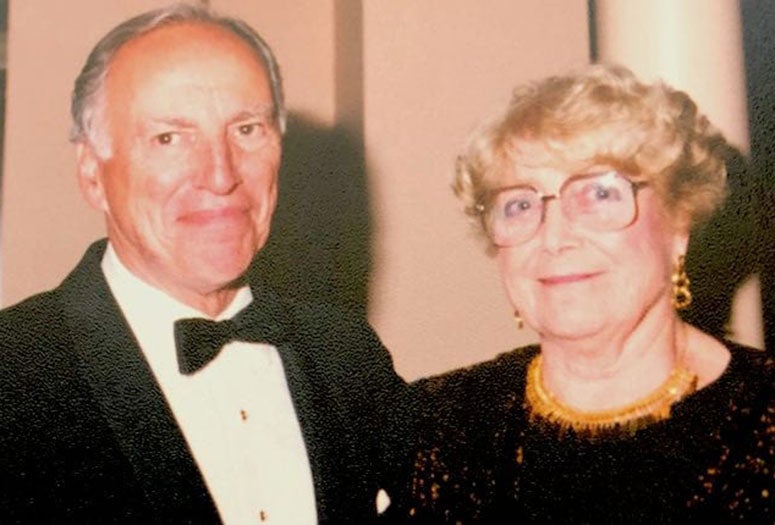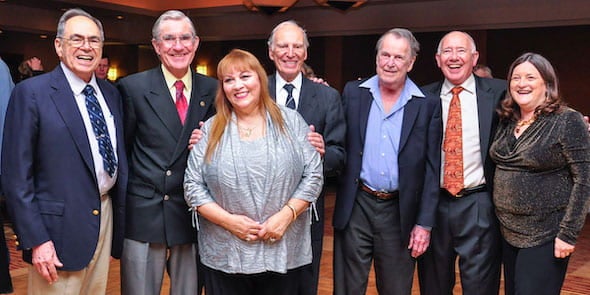Ronald Stebbings, a Rice University emeritus professor of space physics and astronomy, died on Aug. 27 in Rockport, Texas, where he lived after his retirement. He was 91.
Stebbings was an early member of Rice’s pioneering space science department, established in 1963 by emeritus professor Alexander Dessler shortly after President John F. Kennedy’s moon speech at Rice Stadium. Dessler recruited Stebbings to the university in 1968.
Stebbings served as chair of the Department of Space Physics and Astronomy from 1969 to 1974, became Rice’s dean of undergraduates in 1983, and in 1984 was appointed the university’s first vice president for student affairs. He was a key advocate for the addition of the Ley Student Center to the Rice Memorial Center. He returned to the Department of Physics and Astronomy faculty in 1993 and retired in 1995.
A native of London, Stebbings earned a bachelor’s degree and doctorate from the city’s University College London, the latter in 1956. He worked at General Atomics (GA) in San Diego from 1958 to 1965 before returning to University College as a faculty member until his recruitment to Rice.
He and his late wife Mona were masters of Jones College from 1977 to 1982 and presided over Jones’ transition from all women to co-ed in 1980. Both were awarded the Rice Alumni Association’s Gold Medal, the organization’s top honor, in 2000.
Stebbings specialized in atomic, molecular and optical (AMO) physics and authored or co-authored more than 175 papers.
“I first became aware of Ron Stebbings because of his research,” said Dessler, professor emeritus of space physics and astronomy. “Ron’s work, circa 1960, was admirable, definitive and of basic importance to atomic physics and space science.”
“He was highly regarded and a recognized leader in the field of atomic collisions as they related to atmospheric science and astrophysics,” said Barry Dunning, Rice’s Sam and Helen Worden Professor of Physics and Astronomy and Stebbings’ first graduate student at University College. “I recall he was involved at GA in ‘Project Defender,’ which came out of the explosion of an atom bomb in the upper atmosphere that shut down radio communications for a time (to understand) how the atmosphere recovered from such an event.
“We were among the early pioneers studying the creation and properties of Rydberg atoms, atoms excited to high-lying states using lasers,” he said. “These atoms have unusual physical properties. They are physically very large (if opaque, they would be visible to the naked eye) and are very fragile. We exploited their extreme physical characteristics as a unique laboratory in which to study a host of different reactions and physical processes. They remain a subject of great interest even today in connection with quantum computing, the interface between classical and quantum physics and creation of novel ultralong-range molecules.”
Dunning said he and Stebbings jointly edited the first book describing their properties, “The Rydberg States of Atoms and Molecules,” for Cambridge University Press.
“Ron, Neal Lane, King Walters and I were the AMO group here for a long time and laid the foundation for an atomic physics program that has long been recognized as one of the top 10 university programs in the nation,” he said.
“Ron was the last of a breed, in a way, of a whole generation of atomic physicists who were very interested in collisions of atoms and molecule and electrons and ions,” said Lane, Malcolm Gillis University Professor Emeritus, professor emeritus of physics and astronomy and a senior fellow in science and technology policy at Rice’s Baker Institute. “The field has moved on to other topics, but in the late ’50s, the ’60s and even into the ’70s, there was still a lot of focus on what happens when they crash into one another. And Ron could do the experiments, where I tried to do some of the theory.”
Patricia Reiff, a professor of physics and astronomy who earned her doctorate at Rice, said Stebbings’ work on Rydberg atoms seemed interesting but “a bit arcane” until she began to work on NASA’s IMAGE and IBEX missions. “The cross-sections he meticulously determined in the lab were critical for those spacecraft missions to calculate the remote conditions,” she said.
Reiff, who arrived as a graduate student in May 1971, recalled Stebbings “immediately set me at ease with his charm and his genuine interest in students. He listened to you, and when he answered, you knew his suggestion was the right one.”
Dessler recalled Stebbings telling him he planned to join the administration. “He had decided he could contribute more to Rice and to society by moving from his physics research to university service and administration,” he said. “Ron was remarkably persuasive because of his logical presentations, plus his upper-class British accent.
“Just one example illustrates his performance: He changed the way Spring graduation was conducted,” Dessler said. “Consider how difficult it must have been to convince everyone to change something as steeped in tradition as was the Rice graduation ceremony. That he was able to get it changed is a demonstration of his remarkable skill in both logic and persuasion.”
Lane’s time as Rice provost also overlapped with Stebbings’ administrative work. “He was terrific in those positions just like he was in his teaching and research,” said Lane. “He was a great colleague to work with in science and education and administration.”
He and Mona, Lane said, “are the kind of folks who really made Rice what it is.”
He leaves two sons, Vernon ’78, Will Rice, and Martin ’83, Sid Rich. He is predeceased by his wife Mona and a son, Graham. Details on services are forthcoming.



